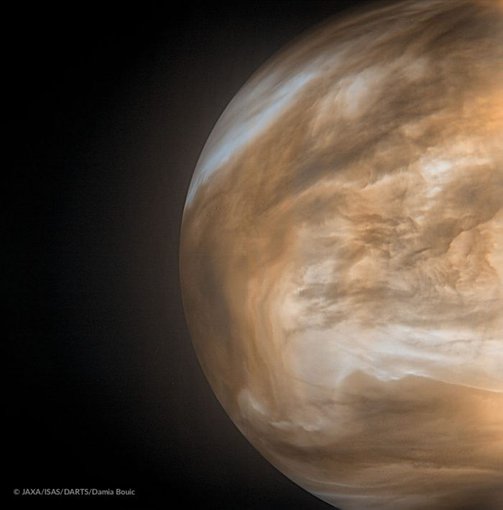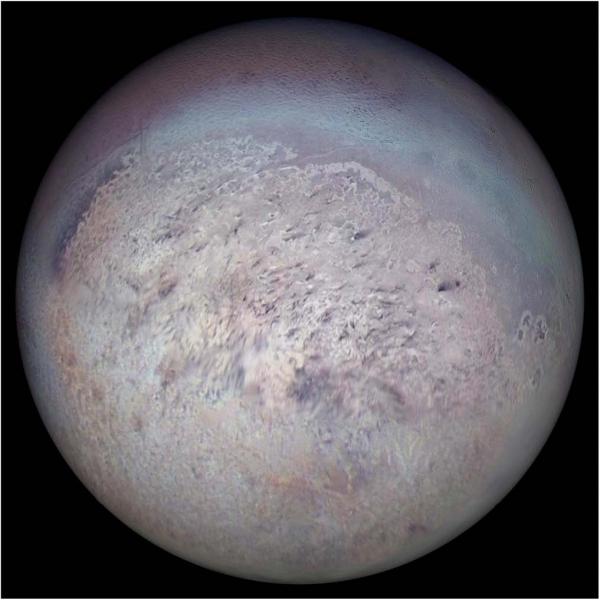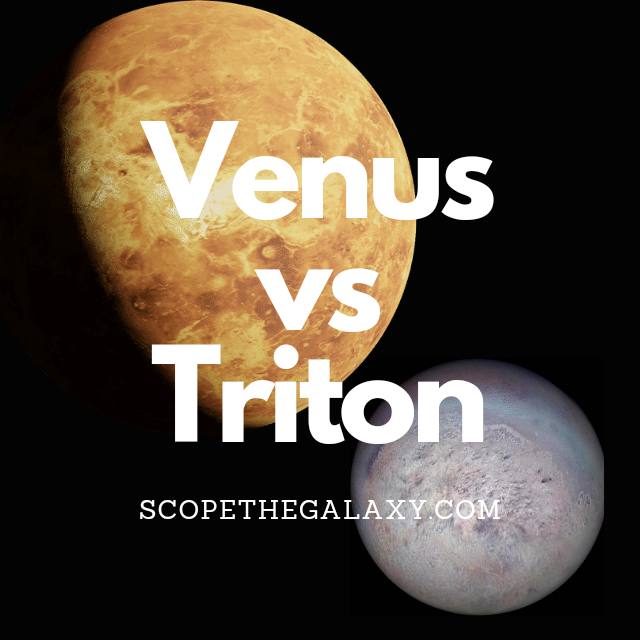*This post may contain affiliate links. This means we may make a commission if you purchase an item using one of our links*
The main differences between Venus and Triton are that Venus is a planet whilst Triton is a natural satellite, Venus is far bigger with a diameter of 12,104km whilst Triton has a diameter of 2,706km, Venus is both the hottest and brightest celestial body in our solar system whilst Triton is neither and Triton orbits Neptune whilst Venus only orbits the Sun.
There are various other differences between the two so, continue reading for a more detailed look at each of these celestial bodies along with their similarities and differences below.
What Is The Planet Venus?
Table of Contents

Venus is the 2nd closest planet to the Sun and is often regarded as Earth’s sister planet. It’s very close to our Earth in size where its diameter is 12,104km. This is just over 600km less wide than our home planet.
Unlike all the planets further outside the Sun’s orbit, Venus and even mercury have no moons orbiting it. The most probable reason for this is due to its closer proximity to it, which means that smaller objects orbit the Sun as opposed to Venus.
Venus is also the hottest planet in our solar system where its surface temperature is 475 degrees Celsius. This is due to a number of factors, like the thicker atmosphere, close proximity to Sun, the reasons for which have been explained in more detail here.
It’s core is hot too, similar to that of the ice giants and Earth, where it stands at 5,200 degrees Celsius.
As a result of this thicker atmosphere, Venus is also able to reflect a lot more of the light the Sun projects at it, making it both the hottest and brightness planet in our solar system. This is why for the longest time, and even till this day Venus is often referred to as the morning or evening star.
The thicker atmosphere is mostly compromised of carbon dioxide, and thick clouds of sulfuric acid. This does result sulfuric acid rain on the planets surface, which of course is very corrosive.
Being so close to the Sun also mean its orbital cycle is much shorter. It takes Venus 225 days to complete a full cycle, on the contrary a single day is actually longer than this where it takes around 243 days for a full rotation around its axis.
This is partially down to its distance from the Sun and the thick atmosphere surrounding this terrestrial planet. The axial tilt on Venus is also different from the other planets in our solar system where it is practically straight at 3 degrees.
All in all this is certainly one of the most interesting planets in our solar system and in many peoples eyes, could very well have supported life in the past based on how close its shape and size is to that of Earth.
What Is The Moon Triton?

Triton is the largest moon of Neptune, whose most unusual feature is its retrograde orbit. Triton is the only major moon in our solar system which orbits in the opposite direction of its planet’s rotation.
First discovered on 10th October 1846 (just 17 days after the discovery of its planet, Neptune) by British astronomer William Lassell, “Triton” comes from a merman in Greek myth; a name which perhaps stems from the composition of this faraway moon.
The diameter of Triton is approximately 2,706km, making it a similar size to Earth’s moon. However, we know that its mass is far less than the first estimates suggested because data from Voyager showed that the surface is icy and highly reflective, a less dense composition than the dark surface of our moon.
This icy surface has resulted in ice based natural satellite displaying temperatures in the region of – 235 degrees Celsius.
This lower density stems predominantly from the water-ice interior encasing a denser rock core. Still, the mean density of 2.06 grams per cubic cm remains higher than that of any of Saturn’s or Uranus’ moons. In addition, Triton holds more than 99.5% of the mass of everything that orbits the planet Neptune and its total mass is greater than every smaller satellite in the solar system combined.
Scientists think that Triton may be an object from the Kuiper Belt that Neptune’s gravity captured millions of years ago. This is because it shares many similarities with the dwarf planet Pluto – the best-known world within the Kuiper Belt.
This frozen world is a land of geological oddities with craters and a collection of depressions and ridges known as cantaloupe terrain. The geysers found on this moon shoot plumes of nitrogen as high as 8km high, which creates a thin atmosphere of nitrogen.
In around 3.5 billion years, Triton’s orbit will travel too close to Neptune, and the planet’s gravitational pull will break the moon apart, creating a ring system.
Similarities Between Venus And Triton
Triton and Venus do have their odd few similarities, which in this case includes the below:
- Both have a hotter central core.
- Both have an atmosphere and a rocky surface.
- Both are a spherical shape.
- Both are part of the same solar system.
- Both have no rings surrounding them.
- Neither have plate tectonics.
- Neither have other moons orbiting them.
- Neither have magnetospheres.
Differences Between Venus And Triton
As for the differences between the two, they include the following:
- Triton orbits Neptune whilst Venus only orbits the Sun.
- Venus has a diameter of 12,104km whilst Triton’s diameter is 2,706km.
- Triton has an ice based surface with occasional volcanic activity whilst Venus’s surface is the opposite and far far hotter.
- Triton has a very thin exosphere composed mostly of nitrogen with small amounts of methane whilst Venus has the thickest atmosphere amongst the terrestrial planets, where it is 90 times the thickness of Earth’s consisting of 95.32% carbon dioxide, 2.7% nitrogen, 1.6% argon and 0.13% oxygen
- A day on Triton takes 5.877 days whilst a Venus day is 243days.
- It takes Triton 5.877 days to orbit Neptune and around the Sun in 165 years whilst Venus orbits the Sun in 225 days.
- Venus has an axial tilt of 3 degrees whilst Triton’s axial tilt is close to 0.
- Triton’s average temperature is around -235 degrees Celsius whilst Venus is the hottest planet with an average temperature of 475 degrees Celsius.
- Venus’ density is 5.24 g/cm³ whilst Triton’s density is 2.06 g/cm³.
- Venus has a mass of 4.867 × 10^24 kg whilst Triton’s mass is 2.14 × 10^22 kg.
- Triton’s gravitational strength is 0.779 m/s² whilst Venus’ is 8.87 m/s².
- Triton is the only moon in our solar system that orbits its planet in a retrograde orbit whilst Venus orbits the Sun as almost all the other planets do, in a nearly circular pattern.
- Triton is tidally locked to Neptune whilst Venus is not tidally locked to any entity.
- Venus is the brightest entity (besides the Sun) in our solar system.
Summary
Although Venus and Triton do share the odd few similarities such as their basic terrestrial composition, the lack of a moon that orbit them and the fact both are part of the same solar system, the two are still very different form one another.
Whether it be in regards to mass, size, temperature, the thickness of their atmospheres, the overall brightness they display and beyond, Venus and Triton are very much distinct entities in their own right.

